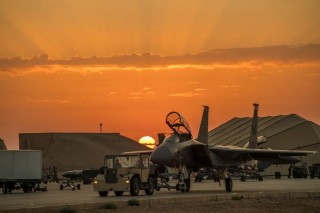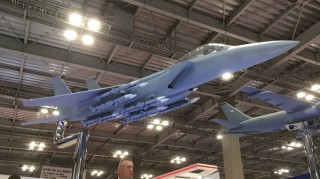Loading
Search
▼ Boeing And Mitsubishi Sign Agreement To Support Japan F-15 Upgrades
- Category:Event
American firm Boeing has signed an agreement with Japanese company Mitsubishi Heavy Industries to support upgrades to Japan’s fleet of F-15 fighter jets.
The agreement, made through the U.S. Direct Commercial Sales process, is part of a larger $4.5 billion modernization program for 98 of Japan’s F-15J/DJ Eagle interceptors ordered through the U.S. Foreign Military Sales process and approved by the U.S. State Department in 2019.
Boeing will provide MHI with retrofit drawings, ground support equipment and technical publications for the upgrade of the first two F-15J aircraft to the Japan Super Interceptor configuration, also known as F-15JSI.
The full suite of upgrades will introduce a new radar, electronic warfare capabilities and weapons. Also included is a new advanced cockpit system running on an advanced mission computer for meant to improve pilot situational awareness.
The new active electronically scanned array radar will be the Raytheon AN/APG-82(v)1 multimode set, which is also being fit on the U.S. Air Force’s F-15E Strike Eagles. Japan had requested 103 radars, including six spare sets, along with 116 Honeywell Advanced Display Core Processor II mission computers and 101 BAE Systems AN/ALQ-239 digital electronic warfare systems.
The upgrade package will also include anti-spoofing GPS gear for more precise navigation, as well as new radios.
Japan’s also requested “aircraft and munition integration and test support.” The U.S. Defense Security Cooperation Agency notification about Japan’s request did not provide more details, but Boeing’s announcement of the contract included artwork of an F-15 in Japanese markings with a Lockheed Martin AGM-158 Joint Air-to-Surface Standoff Missile on its centerline weapon station.
While Boeing has a model of the F-15 Advanced Eagle bristling with AIM-120 AMRAAMs
— Mike Yeo 杨启铭 (@TheBaseLeg) November 28, 2018
Japan had confirmed in its Mid-Term Defense Plan in late 2018 that it intended to procure the JASSM for long-range land-attack missions and integrate it onto F-15s.
However, it’s not clear whether Japan will take up Boeing’s proposal to increase the number of AIM-120 medium-range air-to-air missiles that can be carried by the F-15 to 18, which the company had previously displayed on model at an aerospace exhibition in Japan.
The Japan Air Self-Defense Force operates a fleet of about 200 single-seat F-15J and two-seat F-15DJ Eagle aircraft. These are all configured for an air defense role with virtually no air-to-ground capability, and they serve with seven different operational squadrons throughout Japan, a training squadron and another unit in the dedicated aggressor role, acting as the adversary during training exercises.
The fleet, particularly the two squadrons based on Japan’s southern island of Okinawa, have been heavily engaged in monitoring foreign military aircraft entering Japan’s air defense identification zone in the international airspace around Japan. The Defense Ministry says these foreign aircraft are predominantly Chinese, with Russian aircraft coming in at a distant second.
The Japan Times newspaper recently reported on China’s increased use of an air base in its Fujian province to fly fighter jets near the disputed Senkaku islands. In response, the Japan Air Self-Defense Force scrambles interceptors from Okinawa once the Chinese jets take off from the Fujian base.
The newspaper also reported that the Japan Air Self-Defense Force is scrambling four instead of two aircraft on each occasion, noting that the Chinese base is closer to the disputed islands than the Japanese air bases in Okinawa.
Japan had confirmed in its Mid-Term Defense Plan in late 2018 that it intended to procure the JASSM for long-range land-attack missions and integrate it onto F-15s.
However, it’s not clear whether Japan will take up Boeing’s proposal to increase the number of AIM-120 medium-range air-to-air missiles that can be carried by the F-15 to 18, which the company had previously displayed on model at an aerospace exhibition in Japan.
The Japan Air Self-Defense Force operates a fleet of about 200 single-seat F-15J and two-seat F-15DJ Eagle aircraft. These are all configured for an air defense role with virtually no air-to-ground capability, and they serve with seven different operational squadrons throughout Japan, a training squadron and another unit in the dedicated aggressor role, acting as the adversary during training exercises.
The fleet, particularly the two squadrons based on Japan’s southern island of Okinawa, have been heavily engaged in monitoring foreign military aircraft entering Japan’s air defense identification zone in the international airspace around Japan. The Defense Ministry says these foreign aircraft are predominantly Chinese, with Russian aircraft coming in at a distant second.
The Japan Times newspaper recently reported on China’s increased use of an air base in its Fujian province to fly fighter jets near the disputed Senkaku islands. In response, the Japan Air Self-Defense Force scrambles interceptors from Okinawa once the Chinese jets take off from the Fujian base.
The newspaper also reported that the Japan Air Self-Defense Force is scrambling four instead of two aircraft on each occasion, noting that the Chinese base is closer to the disputed islands than the Japanese air bases in Okinawa.
- July 29, 2020
- Comment (0)
- Trackback(0)



